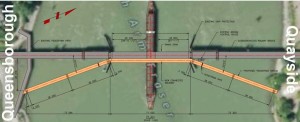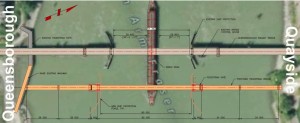There’s been a lot of talk about a new bridge in New West. Some love the idea, some hate it. Paradoxically, those who will use it the most (those right next to it) hate it the most: at least those on the north side of the crossing. Those on the south side seem to insist a better connection is needed.
The initial designs were met with much gnashing of teeth and rending of garments. The consultation was a sham! The options were not viable!! The neighbourhood will not stand for it!!! Pleads of urgency and need were tempered by vaguely Nimby-esque calls for caution and/or outlandish alternatives. Loggerheads were met. Funding sources were debated, petitions were signed, Council was implored.
So the responsible agency hit Ctrl-Alt-Del; sent the engineers back to the drawing board to re-evaluate and return with better options. Third parties were brought in to consult. Previously-discarded options were reconsidered. Numbers were crunched, common ground was sought, new sketches were proffered. More than a year later, the conversation is re-booting, and it is time for you to provide your input. Yet again.
I am talking, of course, about the proposed Quayside to Queensborough pedestrian crossing (what else?).
The people of New Westminster are being asked to comment right now on the two options that have been pencil-sketched for us. We have on-line info, there has been a travelling “whattya think of the bridge now” road show at most recent community events, Ted Eddy has expressed his opinion(s), and all that is left is for you to spend 5 minutes filling out the quickie questionnaire. You have until October 16, 2013.
Allow me to opine.
The current proposals address one of the biggest challenges for the project as originally conceived: the Navigable Waters Act requirement that there be 22 metres of air above the River to allow medium-sized ships to pass into and out of the North Arm of the Fraser River. Less than 22m, then the bridge has to be openable, like the current swinging train bridge in the location.
The engineers have come back with two options to avoid the 22-m high bridge that made for an opposing edifice and a challenging ramp for the less-able-bodied. “Option A” is a bridge that coalesces with the swing span of the existing train bridge, and opens and closes with the rail bridge. “Option B” is a bascule design, which is a drawbridge common to medieval castles and the Chicago River. This would be build adjacent to, and separate from, the train bridge. Each have advantages and disadvantages.
Note there is a language issue here. When talking about a draw or swing bridge, relativity rules the use of the terms “open” and “closed”. Since I (and presumably you) see this as primarily a piece of pedestrian infrastructure, “open” would mean you can walk across it, and “closed” means you cannot. This differs from the mechanical and nautical view of an “open” drawbridge being one where boats can pass. So just to make things clear: when I say open, I mean closed to boats; and when I say closed, I mean open to boats. Clear?
The primary advantage of Option A is cost. The study suggests the entire bridge can be built for $5 Million, which is less than the remaining DAC funds that have been allocated for the project. The bridge will also be slightly lower with shallower ramps and less visual impact for residents.
 |
| OPTION A: You can click the image to zoom in. |
There are however, significant negatives related to this option, mostly related to being literally mated to the existing rail bridge. The owner of the bridge (Southern Railway / SRY Rail Link) has indicated that pedestrians will not be permitted to use the bridge while a train is present (currently, about 8 trains cross the bridge every day) which could cause significant delays for people hoping to cross the bridge.
 |
| OPTION A: You can click the image to zoom in. |
The existing train bridge is 100 years old, and there are some questions about the longevity and engineering reliability of that crossing. Attaching a multi-million dollar piece of City infrastructure to a privately-owned piece of infrastructure approaching the end of its service life may not be the most prudent choice, and may represent “penny wise, pound foolish” planning. What happens to that investment if the rail owner decides to replace their aging bridge in 10 years? What if a moderate seismic event or barge collision closes the rail crossing for an indefinite period? What are the odds SRY’s business plans will change at some time in the 75-year lifespan of a pedestrian crossing? Arguably, these issues may be managed through a deftly-negotiated agreement between the SRY and the City, but some risks will still be there for future administrations to deal with.
Option B will be higher than the existing rail bridge. With 9.6 metres clearance above high water mark, it will not be so big that the on-ramps will be daunting, but high enough that many of the boats that pass the rail bridge will not require the pedestrian bridge to be opened (um… closed). Current estimates have the Option B bridge being open for boats less than half as often as Option A. It will also not be tied physically to SRY’s bridge, so changes in rail operations or replacement of the century-old wooden structure will not adversely impact the accessibility of the pedestrian crossing. This is all good.
 |
| OPTION B: click to make bigger. |
The downside, of course, is the increased cost. At an estimated $9.6 Million, there will need to be a second funding source aside from the remaining DAC funds. The City will have to shake out the couch cushions or borrow to fill the funding gap and get the job done.
 |
| OPTION B: click to make bigger. |
When discussing the Q2Q pedestrian crossing, people talk about it in different terms. Some think of it as a nice amenity, a connection between neighbourhoods, an extension of the park system or a tourist draw. I think of it as all of these things, but primarily as a vital piece of transportation infrastructure. With this in mind I quote myself:
Ultimately, I only hope the crossing will be reliable – one you can count on being there when you need it, and not unexpectedly opened [sic] for a hour at random times – because I see this bridge primarily as a transportation link… then it will be the link we have been missing up to now.
So I vote for Option B.
As for the money, let’s go back in time a bit. The DAC funding was part of a negotiated package the City worked out with the Province over permitting for the Casino. The original allocation of $60 Million looked like this:
$5 M for park improvements across Queensborough;
$35 M for a Multi-use Civic facility in downtown;
$6 M for a new and improved Queensborough Community Centre;
$4 M to improve the docks at the Quay;
$10 M for a Quay-to-Queensborough pedestrian crossing.
The two Queensborough community projects have been delivered: Parks in 2011, the Community Centre in 2013. Last year, the City decided, and received permission to, “reallocate” $8 Million from the last two projects to the MUCF, which became the Anvil Centre. They more recently announced the dock program is not likely to happen any time soon. That leaves $6 Million for the Q2Q Bridge.
Back when the original Q2Q Bridge plan estimates came in around $20 Million, the difference between $10 Million and $6 Million in available DAC funding seemed a little academic- they were still going to have to pop for a significant amount of money to fill the gap. So transferring some of that money with uncertainty attached to the much more certain (as there was a hole in the ground having cement poured into it) seemed like a good idea at the time.
Now that the revised, reasonable, and more acceptable to the community “Option B” estimate is $9.8 Million, the City has a bit of a problem. What to do when the better option is within your original committed budget, but you have now re-allocated such that there is only enough left to pay for the lesser option?
Why ‘water taxi’ is not an option offered for consultation? City Council is affraid this is exactly what majorityin NW will prefer?
Thanks for reading, Vladimir, and for the question.
I cannot imagine why, if the majority in NW would prefer a water taxi, and it had a viable business plan, City Council would be “afraid” of it. If the majority or people preferred it, and it had a viable business plan, then I suspect they would support it.
I didn’t want to get into the Water Taxi option in this post (already too long) and I am still doing some research into it. I suspect I can write more about it in October.